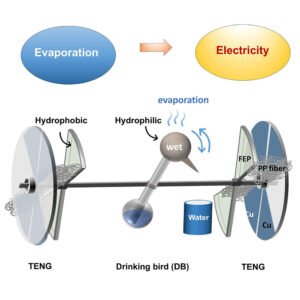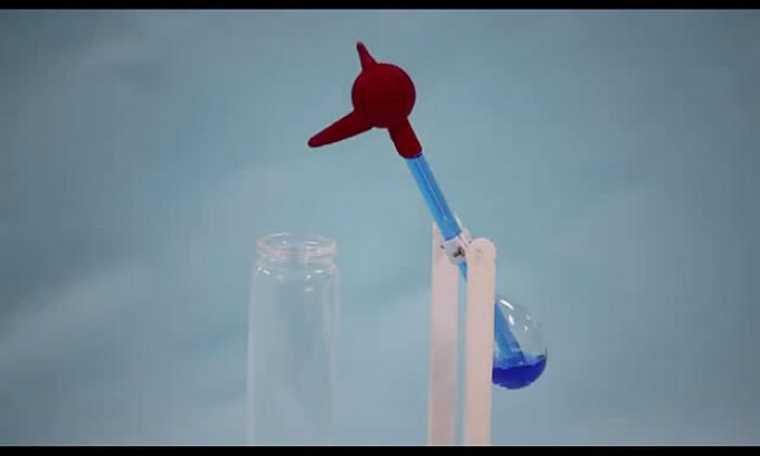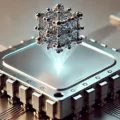Scientists have developed an electrical generator based on the classic ‘drinking bird’ toy that generates electricity from evaporating water.
Previous attempts to generate electricity from water evaporation have resulted in limited success and low voltage outputs. This latest approach conquers those limitations, resulting in an electrical generator that can run for days and produce usable electricity from small amounts of water.
Capturing Energy from the Motion of the Drinking Bird Toy
The key to the unique power generator involves combining a device that converts the heat energy from water evaporation into motion with a device that generates electricity from that motion. In fact, the inventors say exactly this idea motivated them to build the device in the first place.
“I began to contemplate whether we could convert the evaporation energy into mechanical energy first and then translate it into electricity,” said Professor Hao Wu from the South China University of Technology. It was then that the idea of utilizing the drinking bird toy came to mind. With this inspiration, the concept of the drinking bird triboelectric hydrovoltaic generator was born.”
According to the press release announcing the development of the drinking bird generator, “The toy consists of two glass bulbs connected by a glass tube with a highly volatile liquid, methylene chloride, stored within. The top bulb, which includes the bird’s beak and a decorative top hat, is covered in a felt-like material, and the bird’s body is suspended on two plastic legs.”
To start the drinking bird toy, its head is tipped forward until it dips its “beak” in a glass of water. Almost immediately, the water begins to evaporate. This rapid evaporation causes a pressure difference, which, in turn, causes the fluid in the bottom bulb, which is a highly volatile liquid called methylene chloride, to rise through the tube until it fills the bird’s “head.” That movement causes the bird’s head to dip forward into the water, which wets the bird’s beak and starts the process all over again.
Prototype Generates 100 Volts of Useable Electricity
Wu and his fellow researchers focused on the triboelectric effect to capture the toy’s motion and convert it into electricity. This involves placing two materials against each other, which generates electricity when they slide back and forth.


The initial designs were promising but faced challenges since the mechanical energy generated by the drinking bird toy was having trouble overcoming the friction of the triboelectric materials designed to generate that motion into electricity. The researchers overcame this challenge by affixing patterned fibers as the charge transfer materials. In this case the material involved was something called polypropylene (PP) cotton, “enabling the continual energy harvesting from the small mechanical energy induced by the evaporation.”
Once constructed, the researchers tested their drinking bird toy triboelectric nanogenerator (TENG) to see how much energy it could generate. Some initial tests involved powering a calculator or even a small sensor. However, a more sophisticated experiment saw the TENG power 20 LCD screens at once.
Published in the journal Device, the study explains that their device was not only a success but compared to other evaporation-based energy generators that can generate a handful of useable volts of electricity, their drinking bird toy generator generated a whopping 100 volts.
“Our drinking bird triboelectric hydrovoltaic generator (DB-THG) achieves a voltage output of up to 100 V through water evaporation in the natural environment, significantly exceeding the previous study,” explains the researchers.
The team also notes that their generator is highly energy efficient and can run for “several days” using only 100 milliliters of water.
“The drinking bird triboelectric hydrovoltaic generator offers a unique means to power small electronics in ambient conditions, utilizing water as a readily available fuel source,” said Wu, the study’s first author. I still feel surprised and excited when witnessing the actual results.”
Inventors Hope to Build a Commercially Viable Drinking Bird Toy Generator
Next, the research team says they are hoping to build their own customized drinking bird design since their initial prototype used an off-the-shelf drinking bird toy. Ideally, a customized device could result in even more electrical efficiency than their initial design.
The team also says their long-term goal is to create an environmentally safe, commercially viable generator that can generate power from nothing but water.
“We will explore various application opportunities for this device with the ultimate aim of delivering a practical product that can be used in our daily lives,” said Zuankai Wang, the corresponding author of this study and a chair professor at Hong Kong Polytechnic University.
Christopher Plain is a Science Fiction and Fantasy novelist and Head Science Writer at The Debrief. Follow and connect with him on X, learn about his books at plainfiction.com, or email him directly at christopher@thedebrief.org.

